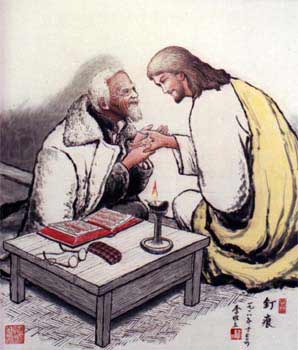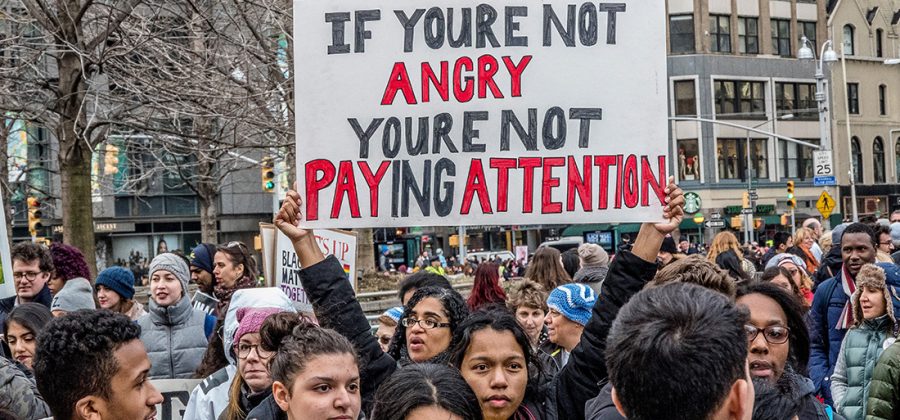A sermon for the 2nd Sunday of Easter for a lively congregation in a Warwickshire village. The gospel for the day is John 20:19-end (text below)
‘Unless I see the mark of the nails in his hands, and put my finger in the mark of the nails and my hand in his side, I will not believe.’ So says Thomas – who is not really “the doubter” but the scientist who needs to see the evidence.

Jesus showed him. He said: ‘Put your finger here and see my hands. Reach out your hand and put it in my side”. Normally we read Thomas’s response as a confession of faith – “My Lord and my God!” with a sense of joy. We could read it very differently – again with Thomas, the forensic scientist examining the body, probing Jesus, talking to to Jesus, as if a patient sufferer, while processing what he is seeing. “They did this to you?” “How deep that wound goes.” “This is what you put yourself through?” “You did this for me?”
The realisation this examination evoked would have a very different tone to the one we are used to. Read it differently. Instead of the tone of triumphant joy – as in “My Lord and my God” there may have been the tone of “Myyyyyy Looooord!” “Myyyyyyy God, what have they done to you?”
Thomas is the one who sees the wounds of Jesus, and the truth is in what he sees.
I want to explore what it is to see the wounds of others and our responses. It’s a growing question because there seems to be a battleground developing between those who want their wounds to be seen and those who very intentionally refuse to look, dismissing people for their whining. The battle has been fought down the ages, but is now being fought with a renewed intensity in the forefront of our politics.
The battle lines have been drawn between those who are “woke” and those who are “anti-woke”. The word “woke” made its way into our vocabulary through its usage in the African-American communities where it means staying “alert” to the wounds of racial discrimination. Its use spread through the Black Lives Matter movement and the word was added to the Oxford English Dictionary in 2017. Being woke is being alert to the woundedness of others. But, most recently, woke has been turned into an offensive word and a term of abuse by those who are anti-woke who accuse the wounded and their sympathisers of being “snowflakes”.

“Unless I see your wounds” – that’s what this is about. The inspiration is Thomas and the wounds he sees, and the wounds Jesus carries. They take us to the heart of the battle.
Can we see one another’s wounds and the pain we bear.
Can I see your wounds? Can I see how hurt you are? Can you tell us what hurts you?
We can only believe when we see the wounds and understand the back story to those wounds.
Gareth Malone has recently done a series where he put together a choir of eight singers to perform St John’s Passion by Johann Sebastian Bach. Some of you may have seen it. What made it so interesting was getting to know the eight people who formed their choir, hearing their stories and seeing their wounds.
For example, a close relative of one of them, a niece, had been killed in a road traffic accident the previous week – and there Simon, her uncle, was there rehearsing, finding the rehearsing something that helped with the wounds.
Another of them, Joy, was one of the few who knew the passion story. She grew up in the church. Her wounds were wounds of rejection. She carried the scars of having been rejected by her parents when she was a baby, and then again felt rejected by her church at the age of 12 when it became clear to her that she was gay. (Incidentally, that has been thought to be an appropriate age for the Holy Spirit to confirm faith in a service of Confirmation.) Here we have a rejection, not a confirmation – with all the wounds and scarring that go with it. Her faith is still important to her. She was wearing a prominent cross of another rejected one.
Already, in two of them, we see their wounds. The wounds we were shown were fairly typical – the wounds of sudden loss and the wounds inflicted on some who are gay. It was only the surface we were touching. We obviously weren’t shown the complications which are personal to each wounding.
Bach himself was sore wounded. By the age of 10 he had lost both his parents. His first wife died after they’d been married 13 years. 12 of his 20 children died before they were 3. Research by John Eliot Gardiner reveals the violent, thuggish world of the young Bach. Gang warfare and bullying typified his schooling with inspection reports showing that boys were brutalised. They were “rowdy, subversive, thuggish, beer and wine loving, girl-chasing, breaking windows, brandishing daggers”. He missed 258 days of schooling in 3 years – kept at home, like many for fear of what went on in school. Do we understand his music more, do we see his musical score better for seeing the scarring and scale of his wounds?
Can we see the woundedness in others? The wounds of those who are gay. The wounds of those who have grown old and tired. The wounds of those who have had to fight through war. Can we see the woundedness of those who have had to flee – the refugee, the jilted. The wounds of those who are black those who are disabled. So many of their wounds have been inflicted by those who haven’t cared for them/us as they should
These wounds matter. The wounded don’t want to hide their wounds. Their wounds are who they are. Our wounds are who we are. They have made us who we are. As I said, it’s the Black Lives Matter movement which has encouraged wokeness. Members of the Black Lives Matter movement insist the wounds are part of who they are. Their history matters – their wounds matter.
With our own loved ones it is important to see their wounds. When a child is upset we want to know where it hurts. With a partner, we want to understand the story of their scars and the wounds they carry.
And all of us want to be believed for the stories we tell about ourselves, our battles, challenges and wounds. That is what is so important about a community like this. Our best chance of being believed is being amongst people who trust one another – who we can trust with our very lives – sheltered from the indifference and cynicism of those too wrapped up in themselves to see the gaping wounds so many have to hide because they fear they’d never be believed.
Some of our wounds are self-inflicted – maybe a relationship breakdown which was my fault, or the wounds may be the result of personal neglect, or the way we’ve misused our bodies. Our sense of shame covers up the wounds.
Through prayer and encouragement
we may begin to open up
to the one who wants to see,
to the one who says “let me see”,
to the one we can trust
with the shame we are showing them,
to the one we trust will believe us,
even God who wants to see, to heal
what matters to us matters to him
what’s wounded us, wounded him,
crowned with agony.
It’s not “wokeness” that alerts us to the pain and wounds of others. It’s our passion for the other which we call compassion. We mustn’t let the anti-woke brigade prevent us seeing the pain and suffering of others. Not seeing why, how and what is hurting rubs salt into the wounds and isolates them from us.
When we are trusted enough for people to show themselves to us, and when we truly see them, we believe. Seeing is believing – and our hearts go out to those who have so trusted us to believe in them. They are believed and beloved. They are known.
Thomas said: “Unless I see the mark of the nails in his hands, and put my finger in the mark of the nails and my hand in his side, I will not believe.” Nor will we believe people unless we also see the marks of the nails, the cuts in their bodies, the scarring of their minds. Unless his/her/their/our nail marks are seen and his/her/their/our wounds felt he/she/they/we will not be believed and will not be beloved.
John 20:19-end
When it was evening on that day, the first day of the week, and the doors of the house where the disciples met were locked for fear of the Jews, Jesus came and stood among them and said, ‘Peace be with you.’ After he said this, he showed them his hands and his side. Then the disciples rejoiced when they saw the Lord. Jesus said to them again, ‘Peace be with you. As the Father has sent me, so I send you.’ When he had said this, he breathed on them and said to them, ‘Receive the Holy Spirit. If you forgive the sins of any, they are forgiven them; if you retain the sins of any, they are retained.’
But Thomas (who was called the Twin), one of the twelve, was not with them when Jesus came. So the other disciples told him, ‘We have seen the Lord’. But he said to them, ‘Unless I see the mark of the nails in his hands, and put my finger in the mark of the nails and my hand in his side, I will not believe.’
A week later the disciples were again in the house, and Thomas was with them. Although the doors were shut, Jesus came and stood among them and said, ‘Peace be with you.’ Then he said to Thomas, ‘Put your finger here and see my hands. Reach out your hand and put it in my side. Do not doubt but believe.’ Thomas answered him, ‘My Lord and my God!’ Jesus said to him, ‘Have you believed because you have seen me? Blessed are those who have not seen and yet have come to believe.’
Now Jesus did many other signs in the presence of his disciples, which are not written in this book. But these are written so that you may come to believe that Jesus is the Messiah, the Son of God, and that through believing you may have life in his name.

